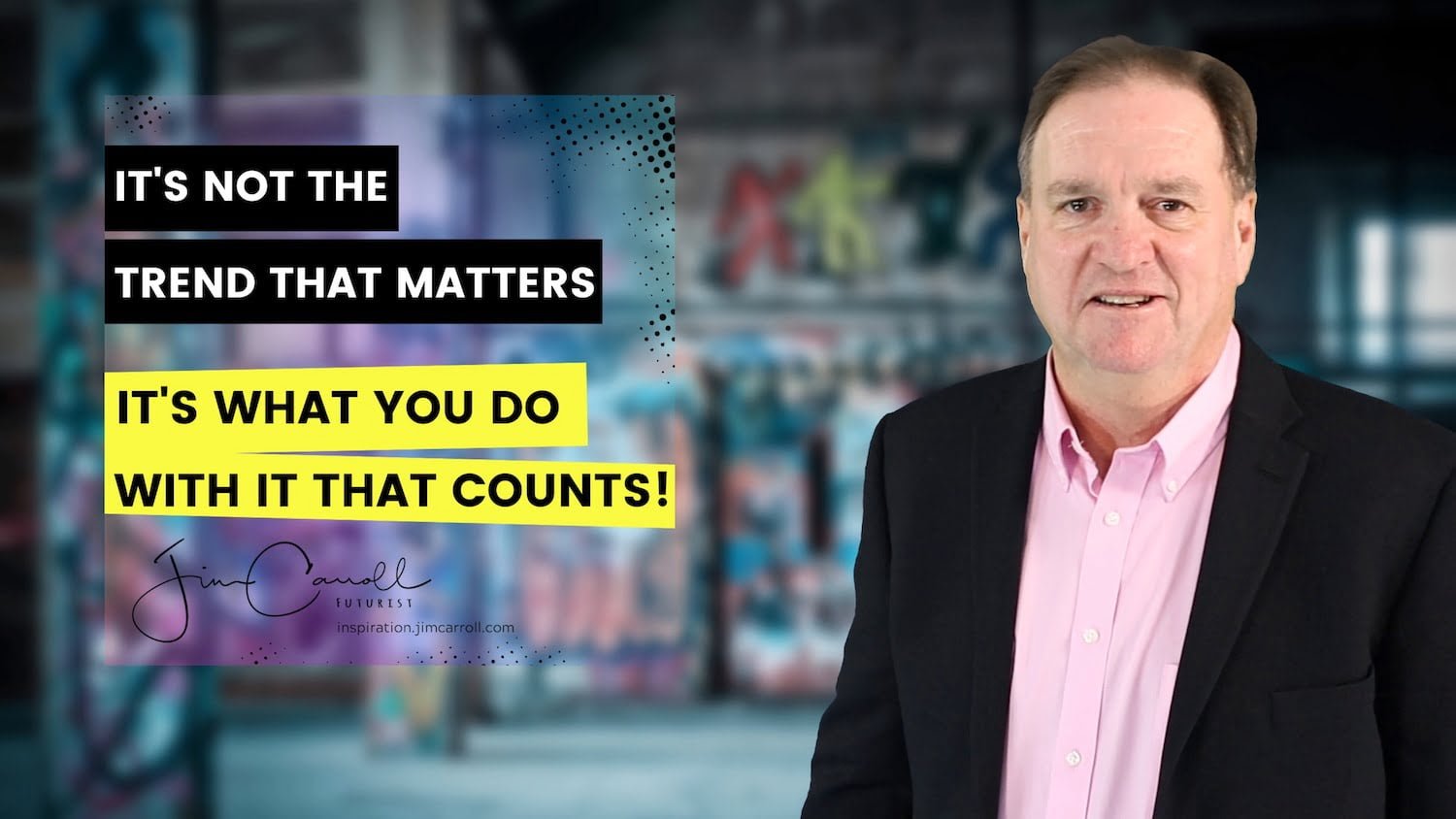“Judge your success by what you actually do. Not just by what you plan to do!” – Futurist Jim Carroll

You know you’ve got a problem but you don’t fix it. You there are opportunities but you don’t chase them. You know there are solutions but you don’t solve them. You know there are creative ideas but you don’t create them.
You are dying from indecision. And let’s face it – indecision is a bad decision!
But here’s the thing – decisions are hard. Especially when you are not making them. This is why, when it comes to the future, it’s not the trend that matters – it’s what you do with it that counts.

So what do you end up doing instead? You wait it out, seeking clarity to guide you, certainty to drive you, and a lack of ambiguity to comfort you. But the world doesn’t work like that anymore, particularly when volatility and surprises have come our new normal.
So what should you do? Make a decision. Move forward. Get going. Start doing! Here are The 12 Behaviors of Decisive Leaders:
- develop the ability to make a decision despite the lack of clarity
- show more willingness to move forward
- be willing to take on risk
- stop focusing on the threat and become relentless on the opportunity
- don’t allow the detractors to slow the clarity of your conviction that its time to move forward
- work to get rid of institutionalized indecision
- implement more deadlines
- speed up your decision making
- break big decisions down into smaller decisions
- always move forward, not back
- pursue the right opportunities – not just the easy one
- above all, stop waiting for clarity
I know I’ve shared it before, but I’ll share it again. What holds back a lot of innovation in organizations is a culture of “aggressive indecision.”
What is it? It’s a form of organizational sclerosis that clogs up the ability of organizations to pursue the future. It’s based on an article I wrote twenty years ago – timeless leadership insight! – with some more valuable lessons that you might use to challenge yourself if you are suffering from this dreadful malady.
Paralyzed by indecision?
Just do it; Fear of the unknown has made doing nothing the new reality in business.
Here’s how to stop spinning your wheels
18 July 2003, The Globe and Mail
by Jim Carroll
You’ve been providing clients with a project quote every quarter — and when you decide to finally press them to close the deal, they are shocked to learn that you’ve been doing it for 2½ years.
You have a new initiative based on a key business trend that is still on the list of “things to deal with” — long after the trend has gone supernova and disappeared.
You finally decide to upgrade some of your significant business systems — only to learn that you’ve waited so long that the software you plan on purchasing is already out of date.
Sound familiar? It should. It’s the new reality in business: aggressive indecision.
Corporations have lost their sense of direction. In the nineties, people had a sense of purpose, and a desire to get things done. “Nobody knows where we’re going, but we’re making great time” could have been the catchphrase. Well, now no one knows where they are going, and they sure are taking their time getting there.
Quite simply, people have decided not to make decisions — and they like it. The result is an economy in which everyone seems to be stuck in a rut, unwilling and unable to move forward.
Why is this happening? In part, fear of the unknown. Executives are afraid to make decisions because the next unforeseen event might prove to have negative consequences. Combine this with the current focus on cost-cutting, a disastrous number of ill-advised decisions in the past decade during the investment bubble, and increasing corporate scrutiny as a result of ethics scandals, and you’ve got a general reluctance with many executives to do anything new.
The fact is, our confidence in the future has been shattered. Corporate nervousness has become the watchword, with the result that everyone is taking the easy way out: Deal with uncertainty by doing nothing.
What should you do to deal with this new reality?
First, look for the warning signs: a business mindset that is adverse to any type of risk; an absence of any new product or marketing initiatives; or an organization that is stuck in a rut, wheels spinning, and no one has decided even to call a tow truck.
Second, realize that aggressive indecision means that you’ll likely have to respond to external pressures faster than ever before. That’s because while people have learned that they can hold off until the very last minute, they are also learning that they can still get things right. This leads to a business cycle that involves extended periods of frustrated waiting, followed by a blur of activity as organizations rush about to respond to the customers’ demands for instant action.
Third, be prepared to change your corporate culture and work processes. You can’t get mad at your clients for waiting for 2½ years and then making a decision with a demand that you be there tomorrow. Don’t let it lead to an expectation gap — when your customer lives with aggressive indecision and you are still geared up to perform and deliver at the slow and steady pace that might have been appropriate in the past.
Finally, make some decisions. Remember what it used to be like when you had the courage to do something? Let’s call it the decision adrenaline rush. It’s good — and it can be addictive.
Want to test it? Find the one big decision that you’ve been deferring the longest, and decide one way or the other. Right now. Didn’t that feel good? Try it again — immediately. See? Isn’t that an amazing feeling?
You might not have made the right decision, and something could go wrong — but at least you’ve decided to start moving forward, rather than spinning your wheels in the mud. Battle aggressive indecision and you’ll find that you’ll gain back control over the future.
If your company is in the indecision funk, there is hope:
- Recognize the problem. Aggressive indecision can be an addictive vice, and like any other thing that isn’t good for you, the first step is recognizing the problem.
- Accept that uncertainty will continue to rule our economy. Making decisions in a vacuum has become one of the most needed corporate skills. Sure, things could go wrong as soon as you do, but that’s the way the world works today. The important thing is that you are again working to define the future before the focus on an uncertain future does you in.
- Accept the inevitability of change. Back in the nineties, people believed that we would see a lot of change in the business world. But now, with all that has gone wrong, it has become far too easy for people to convince themselves that they won’t be challenged by new business models, competitors, or innovation. That’s a dangerous attitude to carry around, and one that can also help to doom you to a state of inertia.
- Watch trends and react appropriately. Now is not the time to let your radar down. Fact is, while you might be suffering from active inaction, your competitors might not, with the result that you are almost guaranteeing yourself some sort of a surprise in the future.
- Redefine goals, establish priorities, and set targets. Companies mired in the mud of aggressive indecision are often directionless, drifting. They’ve lost sight of the need to constantly innovate and establish new directions, with the result that most staff don’t feel any compelling sense of urgency for change. Fix that in a hurry.
- Re-examine your business strategy. For the past several years, organizations have primarily focused on cost-cutting, and yet taking the knife to operations can only go so far. Restate where you plan to go in the next several years, and communicate that vision and direction to your staff.
If your clients or colleagues are suffering, you can:
- Share the risk. If it is the uncertainty that is killing many a business deal, see what you can do to minimize the fear.
- Be clear about the potential downside. If they aren’t making a decision, then why not be more open about any potential problems? If there are risks in the deal, be upfront about them.
- Clearly define the benefits. In an economy in which accountants rule the future, with every expenditure under the microscope, you’ve got to outline the benefits and return on investment clearly.
- Scare them into action. If they are stalling, then put into perspective how their peers, competition or others in a similar position are moving ahead. People hate to be left behind, and if you can provide information on how others are charging ahead it might spur some momentum.
- Be prepared to move on. Sadly, some people have become so bogged down with aggressive indecision that it might be time to cut their losses. If an existing client seems unlikely to do anything, then maybe you’d do better spending your time opening doors to new clients.
- Don’t give up. Continuing aggressive indecision within your client or customer base can drive you to distraction. A continuously negative message can dissuade you. In times like these, you must constantly battle the negative energy that aggressive indecision can place within you.
The natural human inclination, when faced with something that is uncomfortable, is to turn away from it — lingering uncertainty is the root cause of our aggressive indecision. But we can’t afford to do this any longer — our careers, our companies, and our future depend upon our ability to cope with a world of constant change. We’d better get used to it and take the time to learn the skills — and the attitude — that will help us to thrive in this era of uncertainty.




GET IN TOUCH
Jim's Facebook page
You'll find Jim's latest videos on Youtube
Mastodon. What's on Jim's mind? Check his feed!
LinkedIn - reach out to Jim for a professional connection!
Flickr! Get inspired! A massive archive of all of Jim's daily inspirational quotes!
Instagram - the home for Jim's motivational mind!